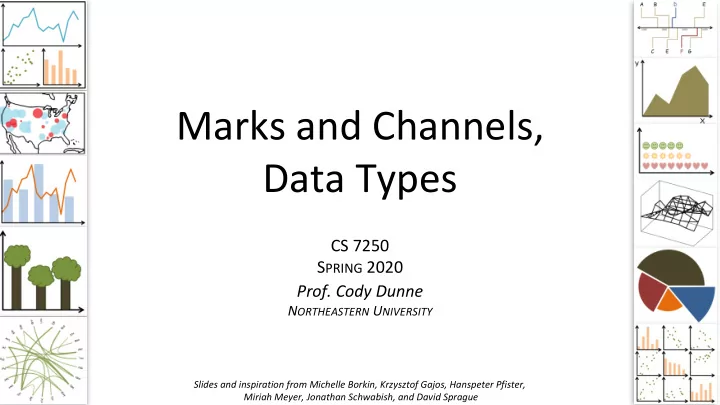

Marks and Channels, Data Types CS 7250 S PRING 2020 Prof. Cody Dunne N ORTHEASTERN U NIVERSITY Slides and inspiration from Michelle Borkin, Krzysztof Gajos, Hanspeter Pfister, 1 Miriah Meyer, Jonathan Schwabish, and David Sprague
I N -C LASS P ROGRAMMING — S OUTH E ND A LTAIR ~25 min total 2
P REVIOUSLY , ON CS 7250… 3
“Graphical Integrity” To achieve graphical “excellence” according to Tufte: 1. Above all else show the data. 2. Maximize the data-ink ratio. 3. Erase non-data ink. 4. Erase redundant data ink. 5. Revise and edit. Tufte, “Visual Display of Quantitative Information” 4 (1983)
“Chart Junk” Chart junk can... persuade, help with memorability, engage Chart junk can... bias, limit data-ink ratio, clutter, lower trust Take-away: it depends on your audience, task, and context... 5
N OW , ON CS 7250… 6
M ARKS AND C HANNELS 7
G OALS FOR T ODAY • Learn the basic visual primitives of visualizations (marks and channels) • Understand how marks and channels are assembled to make visualizations • Learn which marks and channels are most effective for a given task (“perceptual ordering”) 8
Visualization Building Blocks M ARK = basic graphical element in an image Munzner, “Visualization Analysis and Design” (2014) 9
Visualization Building Blocks C HANNEL = way to control the appearance of marks, independent of the dimensionality of the geometric primitive 10
Visualization Building Blocks M ARK : # of attributes encoded: 2 C HANNEL : 11
Visualization Building Blocks M ARK : # of attributes encoded: 2 C HANNEL : 12
Visualization Building Blocks M ARK : # of attributes encoded: 3 C HANNEL : 13
Visualization Building Blocks M ARK : # of attributes encoded: 4 C HANNEL : 14
Visualization Building Blocks M ARK : # of attributes encoded: 2 C HANNEL : 15
Visualization Building Blocks M ARK : # of attributes encoded: 2 C HANNEL : 16
Visualization Building Blocks M ARK : # of attributes encoded: 3 C HANNEL : 17
Visualization Building Blocks M ARK : # of attributes encoded: ? C HANNEL : + position in 3D space 18
Kindlmann (2004) 19
Kindlmann (2004) 20
Visualization Building Blocks Munzner, “Visualization Analysis and Design” (2014) 21
Visualization Building Blocks 22
Visualization Building Blocks Channels : Note: these are all really important concepts when it comes time to coding your visualizations...! 23
How do I pick which marks or channels to use?
“Ordering of Elemental Perceptual Tasks” Cleveland & McGill (1984) 25
“Ordering of Elemental Perceptual Tasks” T ASK : Which segment/bar is the maximum, and what is its percentage/value? Cleveland & McGill (1984) 26
“Ordering of Elemental Perceptual Tasks” This is why pie charts are bad for quantitative tasks Cleveland & McGill (1984) 27
https://www.washingtonpost.com/news/wonk/wp/2013/06/17/the-usefulness-of-pie-charts-in-two-pie-charts/ 28
http://www.datasciencecentral.com/profiles/blogs/10-resources-to-help-you-stop-doing-pie-charts 29
William Playfair (1801) 30
“Ordering of Elemental Perceptual Tasks” Cleveland & McGill (1984) 31
“Ordering of Elemental Perceptual Tasks” Heer & Bostock (2010) 32
Heer & Bostock (2010) 33
34
35
Expressiveness and Effectiveness Effectiveness principle: the importance of the attribute should match the salience of the channel; that is, its noticeability. (i.e., encode most important attributes with highest ranked channels) Expressiveness principle: the visual encoding should express all of, and only, the information in the dataset attributes. (i.e., data characteristics should match the channel) Mackinlay (1986) 36
My Summary: Prioritize choosing the most appropriate channel for each attribute
Expressiveness and Effectiveness Mackinlay (1986) 38
Expressiveness and Effectiveness Mackinlay (1986) 39
Expressiveness and Effectiveness 40
I N -C LASS E XERCISE 41
3, 12, 42 42
3, 12, 42 In- class Sketching: “Three numbers” 20m 1. Break-out into groups of ~3 students. 2. Together (15m) u se pens & post-it notes to sketch as many possible visualizations as you can of these three numbers. 3. No upload required 4. As a class (5m) we will discuss some of the designs and themes. Jonathan Schwabish 43
D ATA T YPES 44
G OALS FOR T ODAY • Learn what are data types and dataset types • Learn what are attribute types • Learn how to pick appropriate visual representations based on attribute type and perceptual properties 45
Data Types T YPE = structural or mathematical interpretation of the data (variable, (row, node) (relationship) (spatial location) (sampling) data dimension) 46
Data Types D ATASET = collection of information that is the target of analysis 47
Data Types D ATASET = collection of information that is the target of analysis 48
Relevant to anyone in the sciences! Slides by Miriah Meyer 49
Slides by Miriah Meyer 50
“Voronoi Tessellation” https://en.wikipedia.org/wiki/Voronoi_diagram 51
Recommend
More recommend